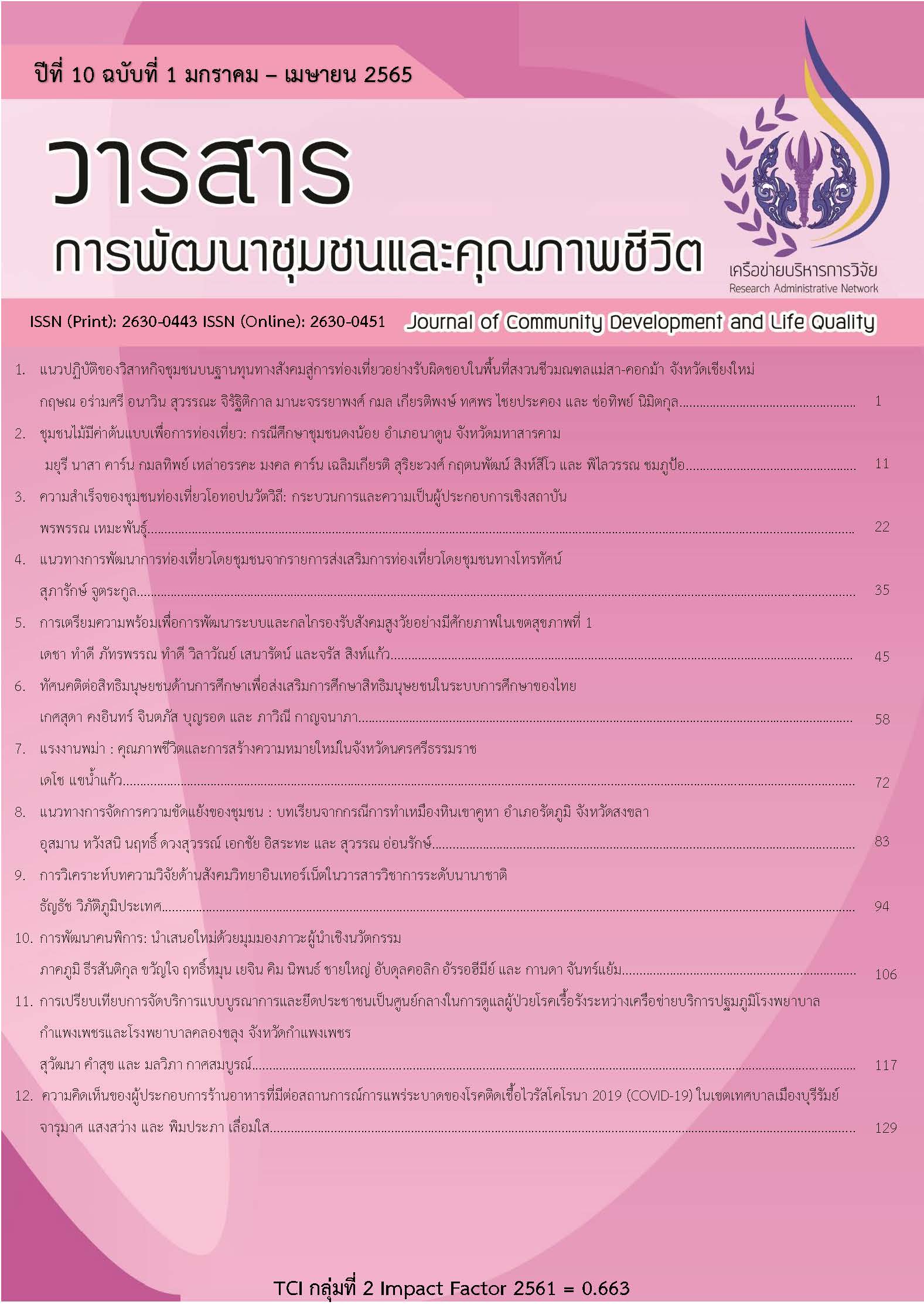ชุมชนไม้มีค่าต้นแบบเพื่อการท่องเที่ยว: กรณีศึกษาชุมชนดงน้อย อำเภอนาดูน จังหวัดมหาสารคาม
Main Article Content
บทคัดย่อ
การศึกษาในครั้งนี้ มีวัตถุประสงค์เพื่อศึกษาสถานภาพชุมชนท่องเที่ยวบนฐานเศรษฐกิจไม้มีค่าและเพื่อพัฒนากิจกรรมท่องเที่ยวที่ส่งเสริมการอนุรักษ์ทรัพยากรป่าไม้ของชุมชน ให้เป็นชุมชนไม้มีค่าต้นแบบเพื่อการท่องเที่ยวของภาคตะวันออกเฉียงเหนือ โดยใช้วิธีการประเมินสถานภาพด้านการจัดการป่าชุมชนอย่างยืน ด้วยตัวชี้วัดสถานภาพด้านไม้มีค่าของชุมชน และการประเมินสถานภาพด้านการท่องเที่ยวโดยชุมชนดงน้อย อำเภอนาดูน จังหวัดมหาสารคาม โดยการสนทนากลุ่มและระดมความคิดเห็นเชิงสร้างสรรค์กับชุมชนดงน้อย ผลการศึกษา พบว่า สถานภาพด้านการจัดการป่าชุมชนอย่างยั่งยืน มีสถานภาพอยู่ในระดับกลาง ค่าคะแนนเท่ากับ 1.92 จาก 3.00 และสถานภาพด้านการท่องเที่ยวโดยชุมชนอยู่ในระดับสูง ค่าคะแนนเท่ากับ 2.48 จาก 3.00 ผลการศึกษายังชี้ให้เห็นว่า การพัฒนากิจกรรมท่องเที่ยวที่ส่งเสริมการอนุรักษ์ทรัพยากรป่าไม้ของชุมชน และการจัดตั้งชุมชนไม้มีค่าเพื่อการท่องเที่ยว จำเป็นต้องศึกษาถึงสถานภาพของทรัพยากรป่าไม้ เพื่อทราบถึงสถานภาพของทุนทางทรัพยากรธรรมชาติ แล้วจึงศึกษาสถานภาพด้านการท่องเที่ยว เพื่อทราบถึงสถานภาพของทุนทางบุคลากรของชุมชนที่จะดำเนินการ เพื่อให้ทีมทำงานมีเป้าหมายไปในทิศทางเดียวกัน พร้อมกับสร้างเครือข่ายความร่วมมือภายนอก เพื่อให้ชุมชนท่องเที่ยวบนฐานเศรษฐกิจไม้มีค่ามีการดำเนินการที่นำไปสู่ความยั่งยืนต่อไป
Article Details

อนุญาตภายใต้เงื่อนไข Creative Commons Attribution-NonCommercial-NoDerivatives 4.0 International License.
กองบรรณาธิการขอสงวนสิทธิ์ในการตรวจและแก้ไขบทความที่เสนอเพื่อตีพิมพ์ในวารสารการพัฒนาชุมชนและคุณภาพชีวิต
บทความหรือข้อความคิดเห็นใด ๆ ที่ปรากฏในวารสารการพัฒนาชุมชนและคุณภาพชีวิต เป็นวรรณกรรมของผู้เขียนโดยเฉพาะคณะผู้จัดทำไม่จำเป็นต้องเห็นด้วย และไม่ใช่ความรับผิดชอบของมหาวิทยาลัยและคณะผู้จัดทำ / บรรณาธิการ
เอกสารอ้างอิง
Ammawong S. and S Kamjadpai. 2017. Enhancing knowledge and awareness in conserving the community forest to the youths through participation between the school, village and temple: a case study in nonsomboun village school, Bolikhan district, Bolikhamxai province, LAO people’s democratic republic. Graduate Studies Journal 14(65): 95-106. (in Thai)
Biodiversity-Based Economy Development Office (Public Organization). 2021. BioTourism. Biodiversity - Based Economy Development Office (Public Organization); Bangkok. 28 p. (in Thai)
Caichompoo, S. 2013. Utilization of Resources, Biodiversity and Local Wisdom for Tourism of Khung Bangkachao, Phrapradaeng District, Samutprakan Province, Academic Journal Phranakhon Rajabhat University, 4(2). 8-15. (in Thai)
Community development center. 2019. Report of thai rural villages. (Online). Available: http://ebmn.cdd.go.th/#/kcc/report (February 20, 2020). (in Thai)
Community Development Department. 2019a. Community tourism: OTOP inno-live. (Online). Available: http://cbt.nawatwithi.com/index_app.php (November 21, 2019). (in Thai)
Duanguppama, S. and P. Phuworakij. 2020. Study of market management guidelines for fish-based products business as a model for community economy of kalasin province. Journal of Community Development and Life Quality 8(3): 649-659. (in Thai)
Emphandhu, D. and R Klabsuk. 2007. Assessment of nature-based tourism site potential at Chiang Mai province. PP. 739-746. In: Proceedings of 45th Kasetsart University Annual Conference: Architecture and Engineering and Natural Resources and Environment. Kasetsart University; Bangkok. (in Thai)
Jamwong, N. 2020. Handbook of forest status assessment training in Dong Noi village. Kasetsart University; Bangkok. (in Thai)
Khampuanbutra, W. 2014. Participation of communities on the cultural ecotourism management at the area of Pratat sub-district, Nadoon district, Mahasarakham province. Area Based Development Research Journal 6(3): 5-22. (in Thai)
Klangsup, N., B. Moungsrimuangdi, T. Lattirasuwan, P. Pitaktansakul, M.N. Khan, R. Sunintaboon and D. Duangnamol. 2021. Development of prototype of valuable woodlot community for extension in Thailand. PP. 114-115. In: Proceedings of Forestry Conference: Kasetsart University; Bangkok. (in Thai)
Luangchanduang, F., S. Kungwon and W. Nunthasen. 2018. The potential of role-model communities in sustainable and creative tourism. Electronic Journal of Open and Distance Innovative Learning 8(2): 52 – 83. (in Thai)
Maneerote, N. 2017. Community Based Tourism Management, Journal of International and Thai Tourism, 13(2), 25-46. (in Thai)
Morgan, R. 1999. A novel, user-based rating system for tourist beaches, Tourism Management 20(4), 393-410.
Nasa, M. and F. B. Hassan. 2016. Assessment of tourism resource potential at Buriram province, Thailand, Asian Social Science 12(10): 27-34.
Onphrom, S. 2020. Criteria and indicators for Thailand sustainable forest management. Royal Forest Department; Bangkok. (in Thai)
Palasak, J. & Sikraiphak, R. 2020. Approach Management to Community Driven Processes of the Tourist Community OTOP Nawatvithi Projects: A Case Study BanWarn, Namkham Sub-district, Muang-Srisaket District, Sisaket Province, Journal of Local Government and Innovation, 4(3), 113-124. (in Thai)
Papassarakan, S., A. Ruksuwan, M. Phanichayanuwat and S. Vithanwatana. 2019. Community needs assessment for capacity development to value added enterprises of ecotourism and Nakhon Nayok province Research report. Suan Dusit University; Bangkok. 213 p. (in Thai)
Suansri, P. and S. Yichorhor 2013. Community-based Tourism Handbook. Institute of Community-based Tourism; Chiang Mai. (in Thai)
Sumpowngern, A. 2018. Communication Approaches for Participation in Forest Resources and Wildlife Conservation through Facebook Page of the Department of National Parks, Wildlife and Plant Conservation, Journal of Humanities and Social Science, Rajapruk University, 4(3), 87-101. (in Thai)
Tanakanjana, N., W. Arunpraparat, N. Pongpattananurak, R. Nuampakdee, and T. Chumsangsri. 2005. Sustainable recreation resources planning support system research report. Kasetsart University; Bangkok. (in Thai)


